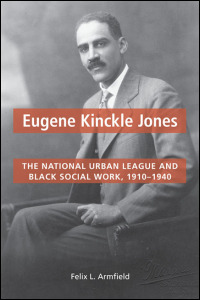 Eugene Kinckle Jones (1885–1954) is an underknown figure in American history, but he was instrumental in professionalizing black social work in America. Author Felix L. Armfield discusses his discovery of Jones and the writing of Eugene Kinckle Jones: The National Urban League and Black Social Work, 1910-1940.
Eugene Kinckle Jones (1885–1954) is an underknown figure in American history, but he was instrumental in professionalizing black social work in America. Author Felix L. Armfield discusses his discovery of Jones and the writing of Eugene Kinckle Jones: The National Urban League and Black Social Work, 1910-1940.
Q: What was Eugene Kinckle Jones’s role in combating racial discrimination in the United States during the early 20th century?
A: Eugene Kinckle Jones, while serving as the executive secretary of the National Urban League, worked to secure adequate jobs and housing for newly arriving southern black migrants to the often urban north. In addition to jobs and housing, Jones continually worked with industry to make sure that sufficient job opportunities were made available to urban black people from 1916 to 1940. Given the industries’ black quota hiring standards, this made Jones’ job even more difficult at times.
Q: How did he come to work for the National Urban League?
A: Jones was invited to join the work of the National Urban League in 1911 by the then executive secretary George Edmund Haynes. Haynes invited Jones to join him at the national office in New York to help carry out the growing work load. Haynes and Jones met each other in Louisville, Kentucky, which is where Jones had settled after completing his education at Cornell University. Soon after Jones joined the Urban League as a field secretary he was named Executive Secretary in 1916 as Haynes moved on to develop the work of training black social work students at Fisk University in Nashville, Tennessee.
Q: Who did he look up to during his formative years?
A: Jones grew up in the all-black historic ward of Jackson in Richmond, Virginia. Jackson Ward was home to some of Richmond’s most noted black citizens–the Jones family included. Jones looked up to such personalities as Maggie Lena Walker, the first woman to own and operate a bank in the country. He also looked up to such persons as John W. Mitchell, the owner and publisher of Richmond’s black newspaper the Planet, and a host of other individuals who inhabited all black Jackson Ward. In addition, both of Jones’ parents were college educated and played a very significant role in the life of young Jones and his community.
Q: Did Civil Rights leaders of the ‘50s and ‘60s cite Jones as an influence?
A: Until now Jones was most likely a footnote. Scholars and activist of the ’50s and ’60s certainly were aware of the work he had done by making the National Urban League a mainstay in urban life. However other forces and personalities had moved on to the national scene with the ’50s and ’60s being the groundswell of Civil Rights activity.
Q: When did you first discover the achievements of Eugene Kinckle Jones?
A: I first encountered Eugene Kinckle Jones when I pledged the fraternity for which he is a jewel (founding member). I only knew of Jones’ activities with the Alpha Phi Alpha Fraternity which he helped to found at Cornell University in 1906. It wasn’t until my dissertation advisor insisted that I take a look at the Urban League papers and obtain my topic for the dissertation. I approached the project with much trepidation and did not initially have any desire to do such a research undertaking. But being a good graduate student I knew it best if I wanted to obtain my Ph. D. I had best follow my mentor and advisor, Dr. Darlene Clark Hine’s advice. After all, she was only the most sought after black historian in the country at the time–second only to Dr. John Hope Franklin. Needless to say, I acquiesced. There Eugene Kinckle Jones awaited me–completely hidden in plain view. The history of the Urban League itself is immediately visible but not so of its leader and pilot–Jones.
Q: Why do you think that he has remained under the radar for so long?
A: Eugene Kinckle Jones has remained under the radar until now largely because of the leadership of Whitney Young, Jr. Young took over at the helm of the Urban League in 1960 just as the Civil Rights Movement gained momentum. Jones had built the Urban League into a non-confrontational organization and some had questioned whether it was useful enough for civil rights agitation. Young’s tenure as leader of the Urban League would throw the support of the Urban League into full use as a civil rights organization. It was during Young’s administration that the Urban League gained its place in the annals of civil rights legends.
Q: What was the most interesting thing that you learned in researching the book?
A: While researching this book, which started out as a dissertation, there have been numerous discoveries. The greatest discovery was the vigilance with which Eugene Kinckle Jones fought for the work of the League and the very significant role he played in the establishment of social work throughout the country. So one of my greatest discoveries was indeed the history of black social work and how social work for black people came to be. Social work for black people rose alongside the Great Black Migration to the urban north. It is this history that promises to enrich our understand of the black migration. It was Jones who stepped in to get the greatest usefulness out of the newly established National Urban League.
